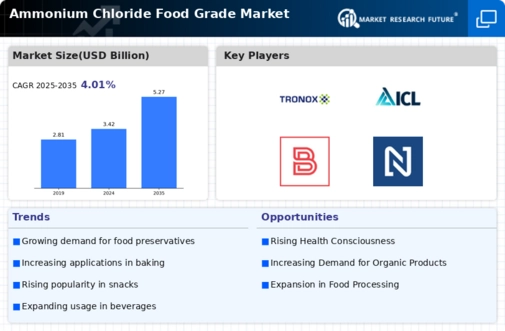Rising Demand for Processed Foods
The Global Ammonium Chloride Food Grade Market Industry experiences an upward trend due to the increasing demand for processed foods. As consumers seek convenience and longer shelf life, food manufacturers incorporate ammonium chloride as a food additive. This compound serves as a flavor enhancer and a leavening agent, which is particularly valuable in baked goods. The market is projected to reach 3.42 USD Billion in 2024, reflecting a growing reliance on ammonium chloride in food processing. This trend is likely to continue as the global population increases and urbanization accelerates, further driving the need for processed food products.
Health Consciousness Among Consumers
The Global Ammonium Chloride Food Grade Market Industry is also shaped by the growing health consciousness among consumers. As individuals become more aware of their dietary choices, there is a rising demand for food products that are not only tasty but also safe and nutritious. Ammonium chloride, recognized for its safety in food applications, is increasingly being used in health-oriented products. This trend is likely to encourage manufacturers to explore new formulations that incorporate ammonium chloride while meeting health standards. Consequently, the market is expected to thrive as health-conscious consumers drive demand for quality food products.
Regulatory Support for Food Additives
The Global Ammonium Chloride Food Grade Market Industry is positively influenced by regulatory support for food additives. Governments worldwide are increasingly recognizing the safety and efficacy of ammonium chloride in food applications. Regulatory bodies, such as the Food and Drug Administration, have established guidelines that facilitate the use of ammonium chloride in food products. This regulatory backing not only enhances consumer confidence but also encourages manufacturers to incorporate ammonium chloride into their formulations. As a result, the market is likely to see sustained growth, driven by both consumer acceptance and regulatory endorsement.
Expansion of the Food and Beverage Sector
The Global Ammonium Chloride Food Grade Market Industry benefits from the expansion of the food and beverage sector. With the rise of new food trends and dietary preferences, manufacturers are increasingly utilizing ammonium chloride to meet diverse consumer needs. The compound is not only used in traditional food applications but also in innovative products such as plant-based alternatives and functional foods. As the market evolves, it is anticipated that the industry will grow at a CAGR of 4.02% from 2025 to 2035, reaching an estimated 5.27 USD Billion by 2035. This growth underscores the compound's versatility and importance in modern food production.
Technological Advancements in Food Processing
Technological advancements in food processing are significantly impacting the Global Ammonium Chloride Food Grade Market Industry. Innovations in food technology enable more efficient and effective use of ammonium chloride, enhancing its functionality in various applications. For instance, advancements in mixing and baking technologies allow for better distribution of ammonium chloride in food products, improving taste and texture. These developments are expected to drive market growth as manufacturers seek to optimize their production processes. The ongoing evolution of food processing technologies suggests a promising future for ammonium chloride in the food industry.















Leave a Comment